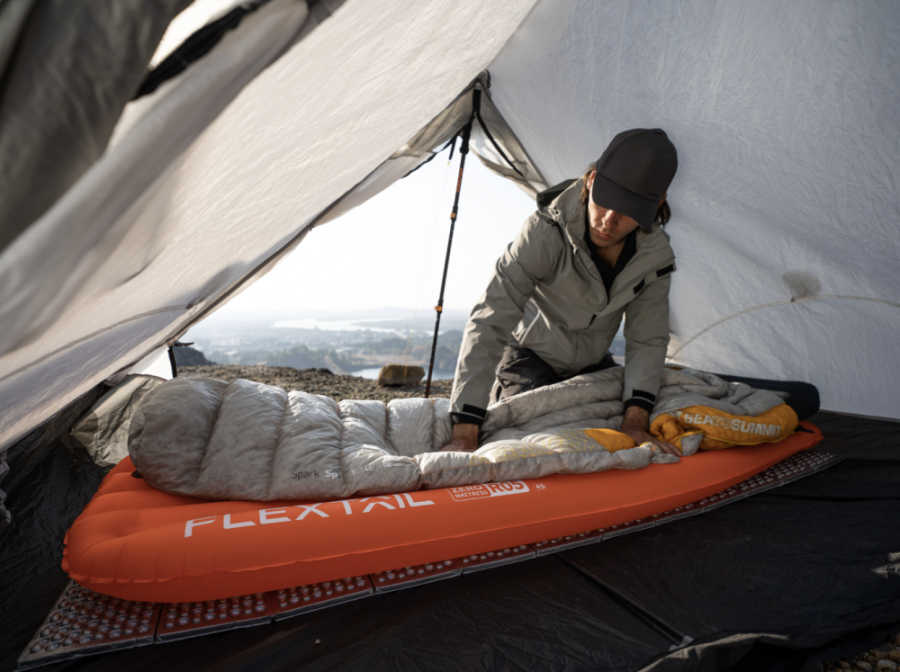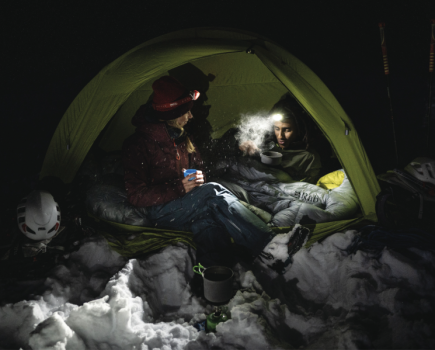A sleeping mat is an essential part of camping gear but your choice of mats can mean the difference between a comfortable night’s sleep or a restless one. A mat isn’t just about comfort though – while it is helpful to have cushioning that stops tossing and turning or aching hips, for anyone camping in cooler parts of the year, a mat that will insulate your body from the cold ground during the night is equally, if not more important.
Main image: The Flextail at camp | Credit: Flextail
The technology has moved on significantly in the last 10-15 years. While many of us remember cold nights curled up on thin foam mats in our tents, the market is now awash with a range of options for every occasion and budget. Our choice of mat is generally about balancing priorities in terms of warmth, weight/size, comfort and price.
Keen, regular campers may opt to have a few choices for different situations. For a multi-day expedition you might invest in a more technical air mat and prioritise a lightweight option, but for a camp where you’re not carrying the mat far, a heavier but comfier mat may be a better choice. Like many things, there are trade-offs and compromises to be made! Some of us opt to stack mats and using a CCF or foam mat underneath can be a good way to add comfort and warmth to an existing inflatable mat without needing to buy a new product geared specifically for colder weather which will likely also be heavier. This can also work as a failsafe, should a puncture in your airmat prove inoperable in the field!
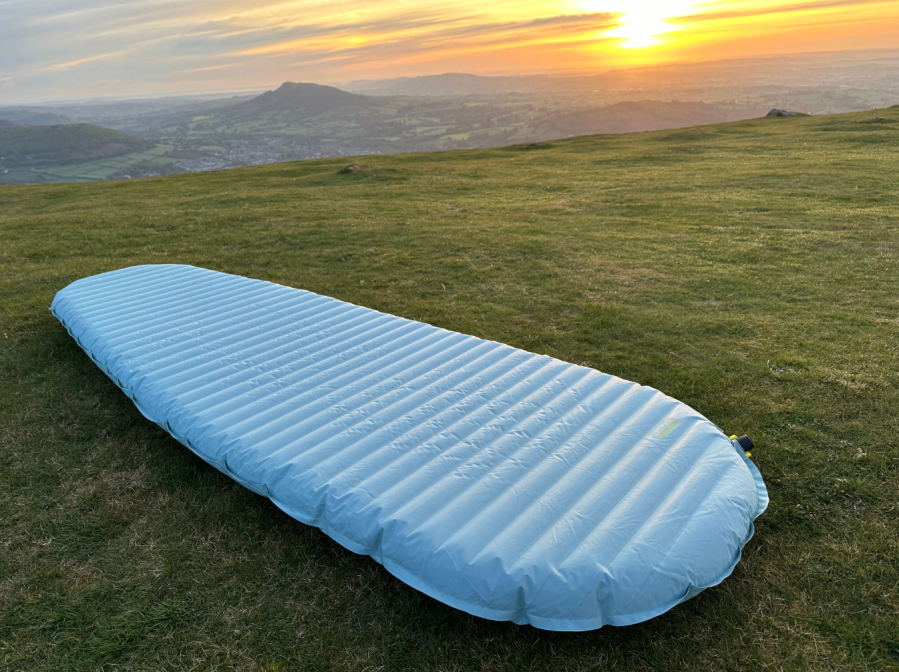
However, it’s also worth considering how you plan to pack your mat – while many will fit inside your bag, because of their size, a foam mat will probably have to be strapped to the outside of your pack. In this test, the mats were all considered ‘unisex’, so it’s worth reading both sets of reviews!
Why you can trust The Great Outdoors
The Great Outdoors is here to help you make the most of your time outside. We have been helping people to explore from sea to summit, valley to mountain top for over 40 years. Our gear tests remain completely impartial. If you are wary of websites that only review brands that advertise with them, or sceptical of social media accounts always singing the praises of their latest freebie, you’ve come to the right place! Our reviews rank #1 for rigour, trustworthiness, and independence, and our gear testing team is the most experienced in Britain. With over 200 years’ experience between us, we are professional mountain leaders and instructors, wildlife photographers and rangers, outdoor authors, guidebook writers and trail addicts.
The best sleeping mats 2025: our expert picks
This article will provide you with knowledge on some of the best sleeping mats around to help you make a judgement on your next purchase. We’ve tested all types of mats from mummy mats, which are more suited to one-person tents, to wide rectangular mats which offer an improved comfort. This guide covers sleeping mats from brands such as Rab, Alpkit, Big Agnes and many more.
| Quick List |
|---|
| Best overall: Therm-a-Rest Neoair XTherm NXT (available from Cascade Designs) |
| Lightest in test: Big Agnes Zoom UL Insulated (available from LD Mountain Centre) |
| Best for winter: Rab Hypersphere Ultra 7.5 Down (available from Rab) |
| Best foam pad: NEMO Switchback (available from WildBounds and NEMO Equipment) |
| Best value: Robens Hybrid Core 60 (available from Outdoor Action) |
Therm-a-Rest Neoair XTherm NXT

Steph Wetherell’s Best in Test
At this price point there’s no doubt that it’s an investment item, but for cold sleepers or those venturing into winter, it’s an investment worth making.- very insulating
- lightweight
- packable
- expensive
| Quick specs |
|---|
| Price: $239.95 / £270 (available from Cascade Designs) Weight: Regular (440g), Regular wide (550g), Large (570g), MAX regular wide (650g), MAX large (680g) Type: Air Materials: 30D ripstop Nylon top, 70D Nylon bottom Dimensions: Regular (51cm x 183cm), Regular wide (64cm x 183cm), Long (64cm x 196cm) Thickness: 7.62cm Rating: R value 7.3 Sizes: Regular, regular wide, long, MAX large, MAX wide cascadedesigns.com |
It has an R value of 7.3 and is by far the warmest mat I’ve ever slept on. The insulation comes by way of two features: a ‘Triangular Core Matrix’ construction, made up of two stacked layers of triangular chambers that creates cells that help capture warmth, and the ‘ThermaCapture’ technology that radiates heat back at you. I was sceptical, but even as a cold sleeper, I genuinely felt warm even when temperatures dipped below zero.
Previous versions of this mat were famous for sounding like you were sleeping on a crisp packet. I’m pleased to report that this version has greatly improved on this (apparently an 83% reduction in sound), and I found that it was really quiet once I was lying down.
It was very easy to inflate, with a large pumpsack that is easy to attach. The Winglock valve makes it easy to make small adjustments lying down without accidently letting out all the air. It’s also easy to roll up and comes with a bag it actually fits into! I genuinely had some of my best ever camping sleeps on this mat. At this price point there’s no doubt that it’s an investment item, but for cold sleepers or those venturing into winter, it’s an investment worth making.
Read more: Steph’s full Therm-a-Rest Neoair XTherm NXT review
Big Agnes Zoom UL Insulated
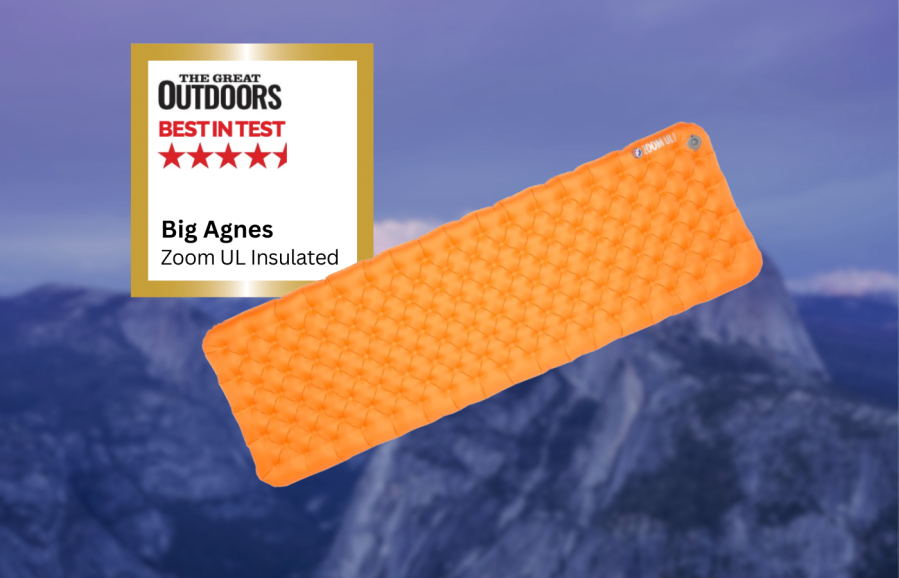
Chris Townsend’s Best in Test
I’ve found the Zoom warm and very comfortable. I think the pattern adjusts better to my body when I move than tubular chambers do.- 3 sizes
- larger outer chambers
- recycled nylon
- comfort
- small pack size
- lightweight
- crackly
- tight fit stuffsack
| Quick specs |
|---|
| Price: $199.95 / £170 (available from LD Mountain Centre) Weight: 400g Type: insulated airbed Materials: recycled nylon ripstop, 2 layers heat reflective foil Dimensions: 51 x 183cm (Regular) Thickness: 8cm Rating: R value 4.3 Sizes: Regular, Regular Wide, Long Wide bigagnes.com |
Rather than vertical or horizontal tubes the rectangular Big Agnes Zoom UL Insulated sleeping mat has an unusual, quilted pattern with a series of small diamond-shaped inflatable sections. Along the sides are larger chambers designed to keep you centred on the mat. Inside the mat there are two layers of heat reflective film for insulation. The mat has an R-value of 4.3 and is designed for extended three-season use. Despite the R-value Big Agnes recommends using a closed cell foam mat under it when sleeping on frozen ground or snow.
I’ve found the Zoom warm and very comfortable. I think the pattern adjusts better to my body when I move than tubular chambers do. The thicker side chambers do work at stopping me rolling off. I think the rectangular shape helps too. If I have one complaint it’s that the mat is quite noisy, creaking and crackling when you move. This hasn’t disturbed me in any way but might annoy a companion.
Read more: Chris’ full Big Agnes Zoom UL Insulated review
Rab Hypersphere Ultra 7.5 Down
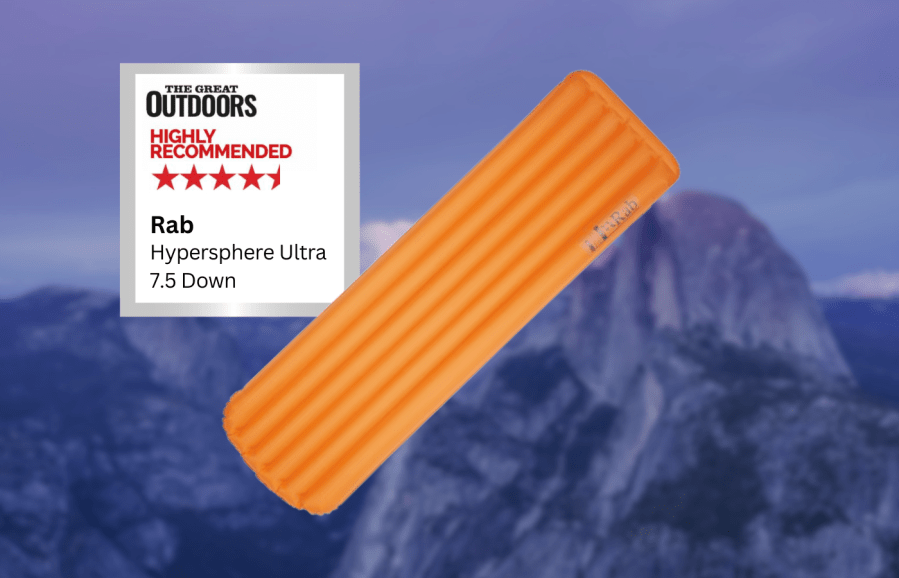
Chris Townsend Highly Recommends
If you’re not going to camp in temperatures well below freezing the Hypersphere is overkill. The penalty is extra weight and bulk but in return you get a very sumptuous mat.- warmth
- down fill
- comfort
- large outer chambers
- recycled nylon
- three sizes
- stuffsack too small
| Quick specs |
|---|
| Price: $250 / £190 (available from Rab) Weight: 630g (Regular) Type: insulated airbed Materials: 20D recycled polyester, 190g 800fp hydrophobic down Dimensions: 51 x 185cm (regular) Thickness: 8cm Rating: R value 7.3 Sizes: Regular, Regular wide, Long wide rab.equipment |
The Rab Hypersphere Ultra 7.5 Down sleeping mat is a luxurious mat designed for extreme cold. The R-value means it should be warm down to -32°C. I haven’t managed to try it at such low temperatures (the lowest ever recorded in Scotland is -27°C) but I did sleep warm on snow at -9°C. For this level of warmth the Hypersphere Ultra is quite light. The reason for this is the down fill, which also makes for a soft, comfortable mat, especially if you don’t inflate it fully.
The Hypersphere has longitudinal chambers. The outer chambers are oversized to help keep you on the mat. I found this works well. The soft-shell fabric is comfortable. The mat comes with a pump sack and this should be used rather than blowing it up by mouth. Although the down is hydrophobic you still don’t want to introduce moisture into it. I think it would take a great deal of effort to inflate it by mouth anyway. Read more: Chris’ full Rab Hypersphere Ultra 7.5 Down sleeping mat review
Nemo Switchback
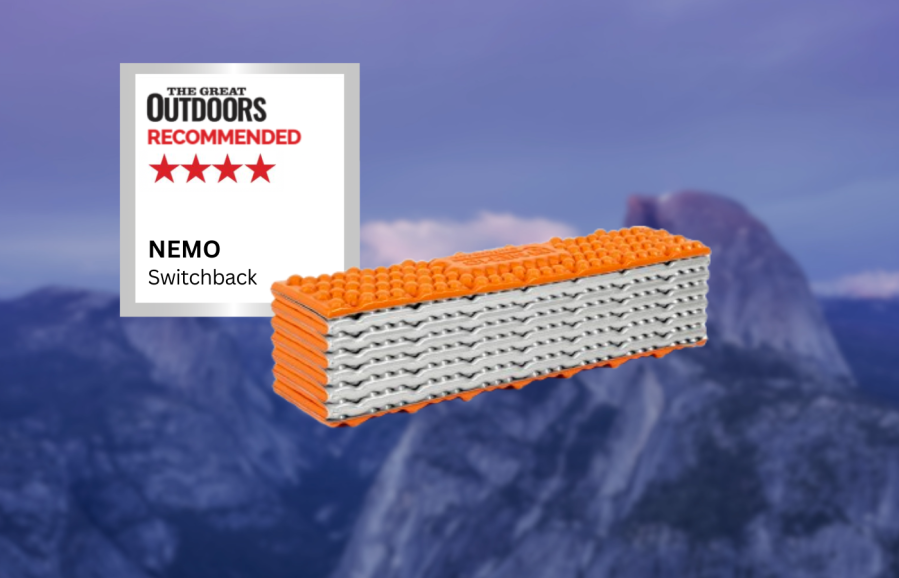
Steph Wetherell recommends
This was definitely more comfortable than expected, and I did feel the cold less than I anticipated.- higher R value than other foam mats
- not cheap
- bulky
| Quick specs |
|---|
| Price: $59.95 / £59.99 (available from WildBounds and NEMO Equipment) Weight: 420g Type: Closed-cell foam Materials: PE Foam Dimensions: 51cm x 183cm Thickness: 2cm Rating: R value 2 Sizes: Regular, short nemoequipment.com |
The Nemo Switchback is a technical Closed Cell Foam (CCF) sleeping mat featuring hexagonal nodes that create more comfort than the width of the foam itself would suggest. I was a little concerned that being plus size, the nodes might compress under my weight.
However after a good amount of testing over several months, the nodes have shown no sign of squishing, likely because of the dual-density Axiotomic foam that tops a softer lower layer with a stronger and more durable top layer. The nodes are also designed so that as you concertina the mat up while folding it, they ‘egg box’ into each other, helping it fold up compactly, but it’s still bulkier than an airmat. The same nodes also aid in the warmth trapping process – the sleeping bag doesn’t compress completely under you. There’s also a metalized thermal film layer to reflect body heat.
Read more: Steph’s full Nemo Switchback review
Robens Hybrid Core 60
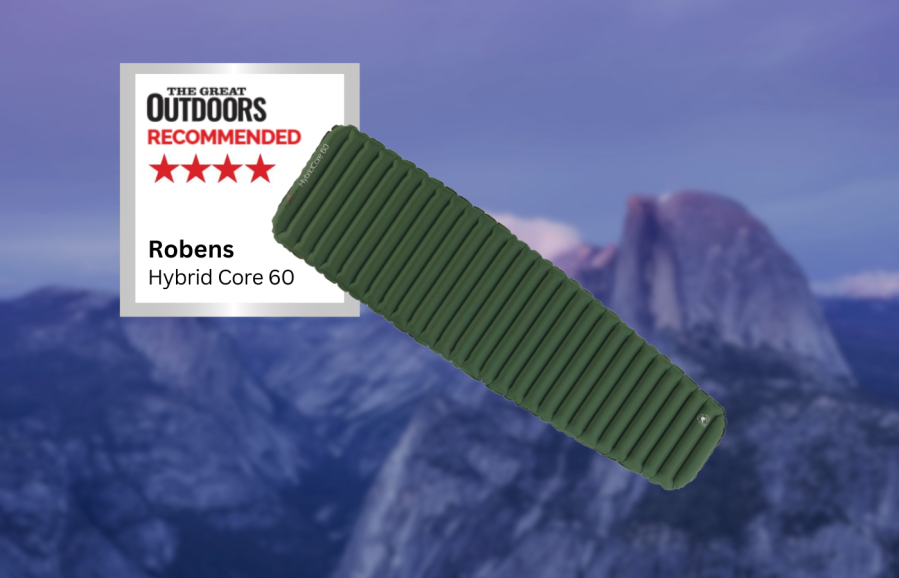
Chris Townsend’s Best Value
For the price this mat is great value and should be adequate for all but the coldest winter nights.- lightweight
- small pack size
- comfort
- sensibly sized stuffsack
- cost
- recycled material
- only one size
- pump sack not provided
| Quick specs |
|---|
| Price: no US shipping / £106 (available from Outdoor Action) Weight: 522g Type: insulated airbed Materials: recycled 20D polyester, 2 layers recycled MicroThermo Highloft polyester, 1 foil layer Dimensions: 51 x 185cm Thickness: 6cm Rating: R value 4.1 Sizes: one robens.de |
The Robens Hybrid Core 60 is a low-priced mat that performs well. It’s not as light as the Big Agnes Zoom UL and doesn’t pack up as small but it’s still quite light and compact. It tapers towards the foot from about halfway along its length but not as much as many mats. The horizontal chambers contain two layers of synthetic insulation separated by a reflective foil layer (hence the name) for warmth. I found the fully inflated mat warm at -2.5°C.
The outer material is a soft polyester that feels comfortable against the skin. The mat crackles very slightly but not enough to disturb anybody unless they have very sensitive hearing. It has a low-profile valve which makes blowing it up by mouth a little awkward. No pump sack is provided. One is available separately at £17.99. The valve closes when you remove your mouth so you don’t lose any air, which does make inflation a bit easier. I’d still rather use a pump sack or an inflation device though. The valve can be held open for deflation with the end of the puller on the valve cover, which works well.
Read more: Chris’ full Robens Hybrid Core 60 review
Flextail Zero Mattress R05

Steph Wetherell’s verdict
Overall, it is a warm mat and the comfort, weight and size of the mat are great for the price point.- price for comfort and weight
- not as warm as advertised
| Quick specs |
|---|
| Price: $139.99 / £109 (available from Flextail) Weight: Mummy (542g), Regular (710g) Type: Air Materials: 20D Ripstop Nylon Dimensions: 65 x 183cm (regular), 55 x 183cm (mummy) Thickness: 10cm Rating: R value 5.6 (regular), 6 (mummy) Sizes: Regular, mummy, regular plus, mummy plus flextail.com |
The Flextail Zero Mattress R05 is an impressively compact inflatable sleeping mat for the price point, coming in only slightly bigger and heavier than some of the premium mats on the market but at half the price. I found it a comfortable mat to sleep on, with the baffles running lengthways down the mat and slightly larger outside baffles that helped to keep me centred on the mat. The disappointment for me was the warmth. The mummy option I tested claims an R value of 6, which was incredibly high for the weight and packability that this offers. Sadly it didn’t meet that expectation. This may be because the insulation inside the mat doesn’t cover the outer two baffles. I imagine this is for weight/size reasons, but it seems like a strange choice in a mat with this high an R rating.
Depending on your sleep position and size, this may not be an issue, but I found parts of my body were often coming into contact with these outer two baffles and I woke up feeling these cold spots more than once (especially that time that I was camped on a bit of a slope!).
Read more: Steph’s full Flextail Zero Mattress R05 review
Therm-a-Rest NeoAir Xlite NXT
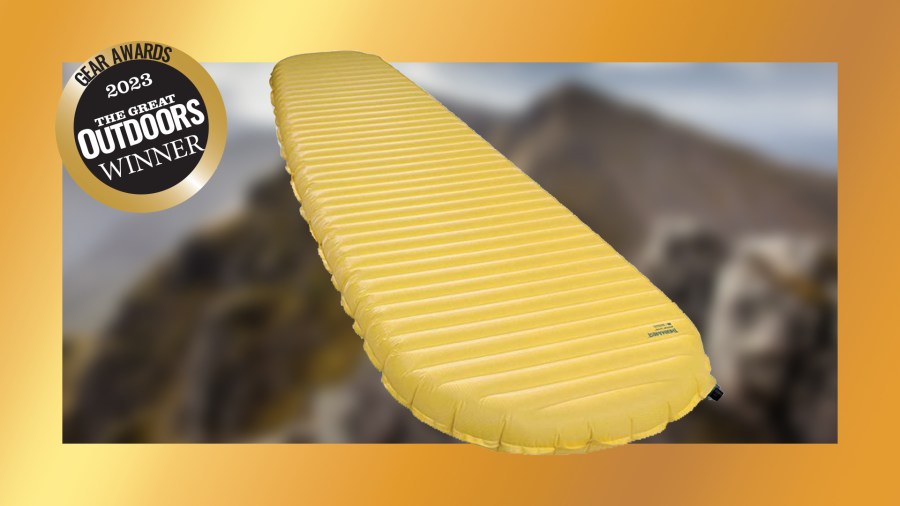
TGO Gear Award Winner
Performance and low weight make it an excellent choice for high camps and multi-day trips, but it does come at a premium price.- Weight
- Packability
- Warmth
- Price
| Quick specs | |
|---|---|
| RRP: $209.95 | £210 Weight: 378g Rating: 4/5 Type: air Materials: 30D rip HT nylon, polyurethane Dimensions: 183x51cm (R) Thickness: 7cm Sizes: Short (330g, 168x51cm) + Regular + Regular Wide (440g, 183x64cm) + Regular Long (470g, 196x64cm) Rating: R-value 4.5 |
This mat gained the top spot in The Great Outdoors Awards for 2023, with the jury recognising it for its Thermacapture lining, a heat reflecting layer within the mat that ups its R-value to an impressive 4.5. The previous version of this mat had a reflective lining, but this was rustly and made for a noisy sleep. With this new version, Therm-a-rest have got rid of that issue and upped the insulating value without adding any extra weight,
The ThermaCapture material within the previous mat would rustle whenever you moved. That problem doesn’t exist any more. It offers an extremely comfortable, warm and a quiet night’s sleep now.
The NeoAir is a compact, rounded mummy shape and a small pack size of 20x13cm. It is easy to inflate with the pump sack that comes with it and has a repair kit with cleaning wipes and stick-on patches. Performance and low weight make it an excellent choice for high camps and multi-day trips, but it does come at a premium price.
Read more: Therm-a-Rest NeoAir Xlite NXT review
Available from: thermarest.com
RAB Ionosphere 5
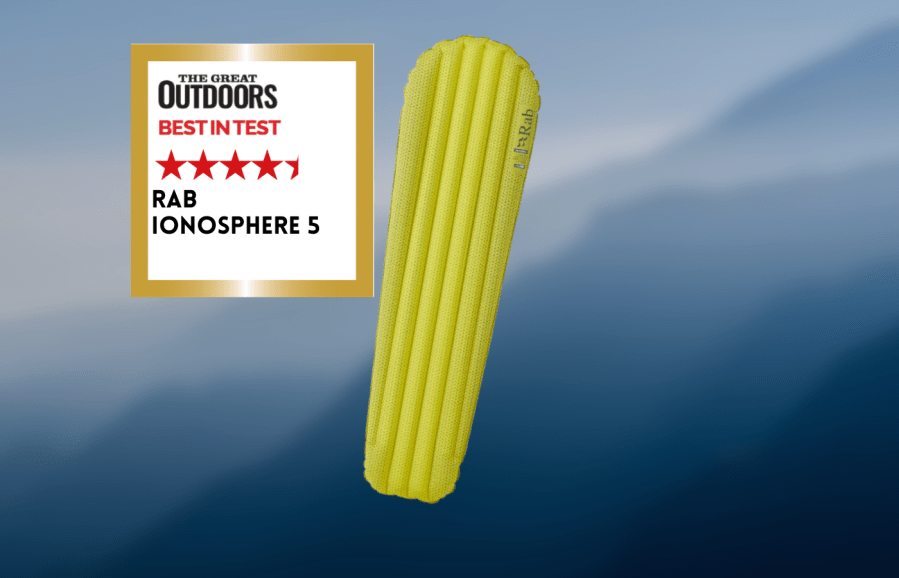
David Lintern Best in Test
The Ionosphere 5 hits a sweet spot of comfort, warmth, packability and price and addresses some environment concerns with it’s use of materials.- Warmth
- Pack Size
- None
| Quick specs | |
|---|---|
| Price: £170 Weight: 633g (regular) Type: air mat Materials: 20D Recycled Polyester outer fabric with internal TPU Coating and fluorocarbon free DWR, and Stratus™ R 100% recycled polyester insulation 160gsm with TILT. Dimensions: 183x51cm (regular) Thickness: 8cm Rating: 4.8 Sizes: Regular, Long wide Women’s version: unisex rab.equipment |
The Ionosphere 5 sleeping mat is a comfortable, warm, and lightweight option that is suitable for both tall and restless sleepers. It features baffles along the length and oversized tubes on the outer edge to prevent rolling off during the night. The mat is internally insulated with synthetic fill and reflective film, and materials are recycled. The R value of 4.8 is realistic, and no cold spots were experienced during cold test camps. The inflation bag fits securely onto the valve, and it only takes five bags of air to inflate. The Ionosphere 5 packs down into a soft pouch, making it easy to use. The 20D shell is tough enough for long-term camp use, and a repair kit is included. The mat addresses some environmental concerns with its materials and the 20D shell is tough enough for long-term camp use. Overall, the Ionosphere 5 sleeping mat is a great choice for those seeking a comfortable, warm, and lightweight option.
Read David Lintern’s full Rab Ionosphere 5 Review
Mountain Equipment Mirrostat 7.0
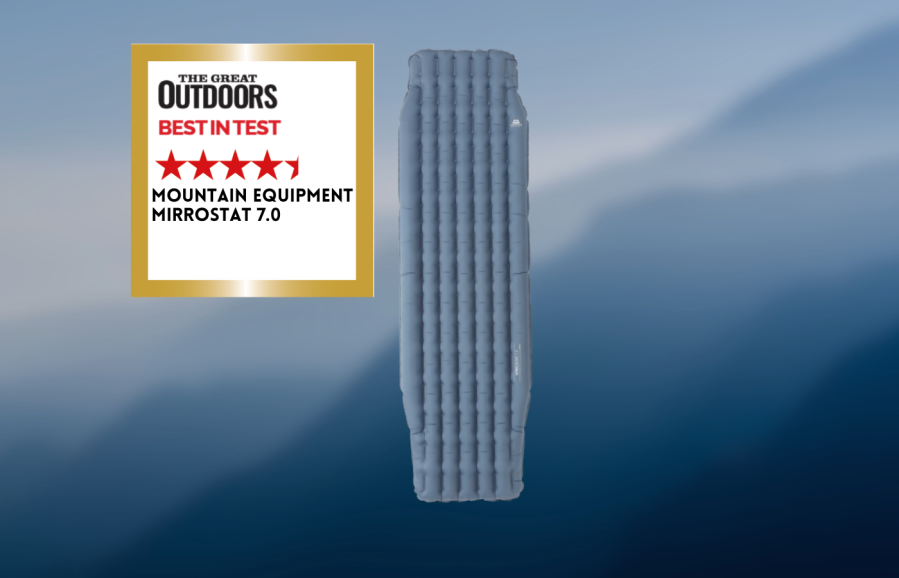
Kirsty Pallas’ Best in Test
This is a fantastic mat if you’re looking for something warm and light, and willing to pay a slightly higher price for it.- Weight
- Warmth
- Price
- Pump sack shape
| Quick specs | |
|---|---|
| Price: £200 Weight: 535g Type: Air Materials: Recycled 20D plain weave polyester, TPU lamination, Mylar reflective film Dimensions: 190cm x 51cm for regular Thickness: 9cm Rating: 4.5 R-value Sizes: Regular and long Men’s version: Unisex URL: https://www.mountain-equipment.co.uk |
The Mirrostat 7.0 is Mountain Equipment’s top-end sleeping mat for warmth and weight, offering impressive insulation due to its mylar reflective film. It is not a women’s mat or a petite size, making it suitable for winter use but still lightweight for cold weather. The mat features vertical baffles with slight spaces between each, which saves weight but remains warm and comfortable. The two outside baffles are larger to keep you in the middle, allowing you to sleep without feeling restricted. The mat is rectangular with slightly shaved corners to save weight without restricting sleeping.
The pumpsack, part of the stuff sack, folds out when pulled out, but it is long and narrow, making it difficult to manage in a one-person tent. The valve is multifunctional and includes a repair kit. The recycled polyester is the lowest denier at 20D, shaved off some weight but may be slightly less durable than other mats. The Mirrostat 7.0’s packed size is 28cmx10cm, but it can be squeezed down if packed next to something else. When deflated and rolled up, it is small and light compared to other mats. This mat is a fantastic choice for those looking for warmth and light at a slightly higher price.
Read Kirsty’s full Mountain Equipment, Mirrostat 7.0 Review
Thermarest Z Lite SOL
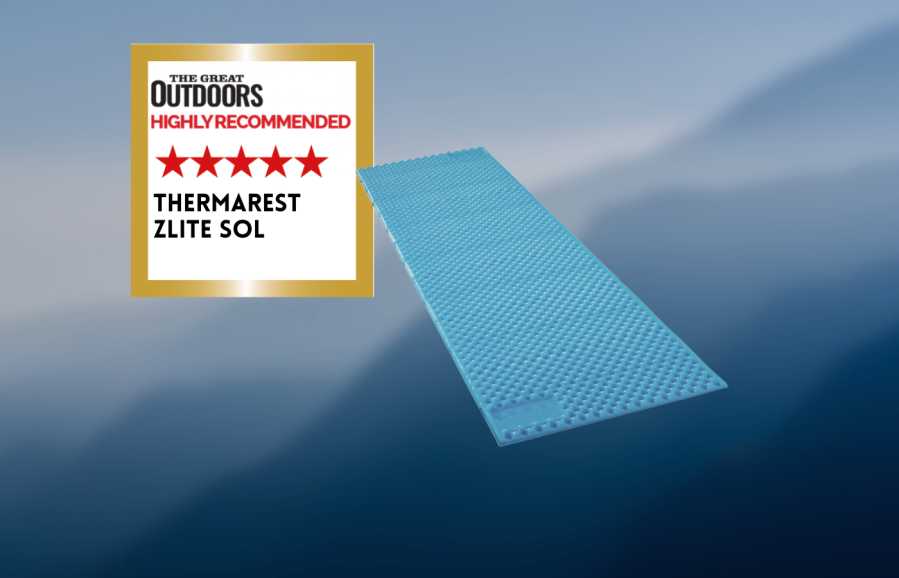
David Lintern Highly Recommends
My original lasted over a decade and still works, although it has lost a little volume – that’s hundreds of nights out.- Durability
- Warmth for weight
- Value for money
- None
| Quick specs | |
|---|---|
| Price: £60 Weight: 390cm (regular) Type: Foam, non-inflating Materials: Polyethylene foam Dimensions: 51cm x 183cm (size Regular) Thickness: 2cm Rating: 2.0 Sizes: Regular, small Women’s version: unisex www.thermarest.com |
The Z lite SOL sleeping mat is a popular outdoor gear due to its simplicity, indestructibility, and ability to provide protection from the ground for minimal weight. Its slivered surface adds 0.3 to its R value without weight penalty. Both Z lites have an eggbox-like construction, providing more ‘cush’ than flat-surfaced closed cell foam mats. While not as thick or comfortable as air mats, it is thick enough for summer use without feeling cold at night. The foam absorbs very little water and can be easily stacked with an air mat for colder weather and puncture protection. The foam absorbs very little water, making it ideal for family camps. The original Z lite SOL lasted over a decade and still works, although it has lost some volume. It is a practical and practical choice for backpacking trips, especially for families with kids who are tough on kit. The original offers better value for money than other camping items.
Read David Lintern’s full Thermarest Z Lite SOL Review
Thermarest Women’s ProLite Plus
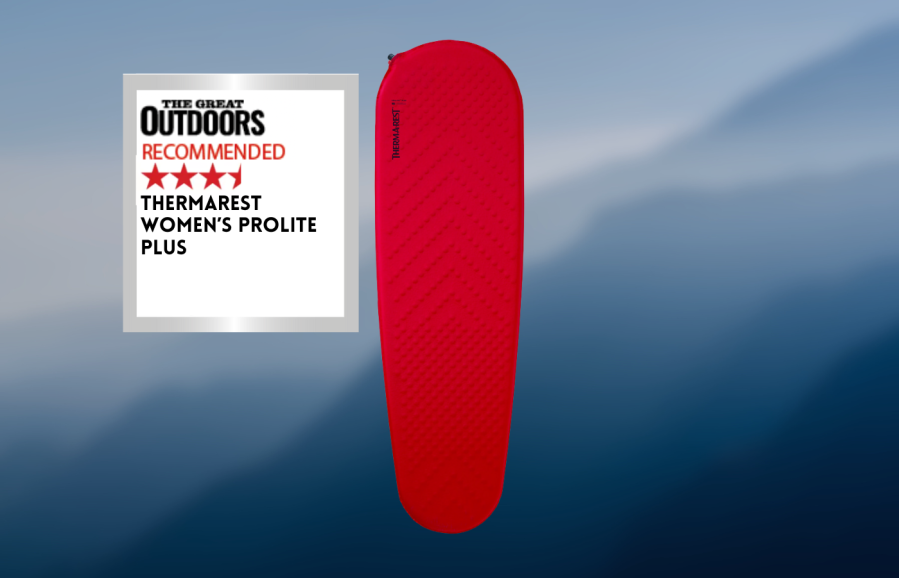
Kirsty Pallas Recommends
Overall, this is a good model if you’re happy to carry something a bit bigger and are looking for a lower price tag. It’s a great compromise between the full air mats and the only foam mats.- Warmth
- Price
- Packed size
- Thickness
| Quick specs | |
|---|---|
| Price: £130 Weight: 695g Type: Self inflating foam Materials: 50D mini hex rip polyester, urethane foam Dimensions: 168cm x 51cm Thickness: 3.8cm Rating: 3.9 R-value Sizes: Regular Men’s version: Yes URL: https://www.thermarest.com/ie |
Thermarest’s ProLite Plus sleeping mats are lightweight and comfortable, with a Women’s model that is shorter and warmer than the standard model. The R-value of this mat is 3.9, making it suitable for smaller and cooler sleepers. Self-inflating allows for easy opening and closing of the valve, maximizing airflow and making deflating and getting the air out easy. The winglock valve is large and one-way, making it easy to deflate. The mat is slightly mummy-shaped, providing a comfortable night’s sleep. However, side sleepers may feel pressure on their shoulder and hips on hard surfaces, which is less noticeable on softer ground or with additional padding.
The ProLite Plus’s pack size is the largest in this test, but it still provides insulation if punctured, unlike full air mats. It is a good compromise between full air mats and foam mats, offering a larger size and better comfort. It is a great compromise between full air mats and foam mats, offering a better fit for those looking for a lower price.
Read Kirsty’s full Thermarest, Women’s ProLite Plus Review
Nemo Tensor Extreme
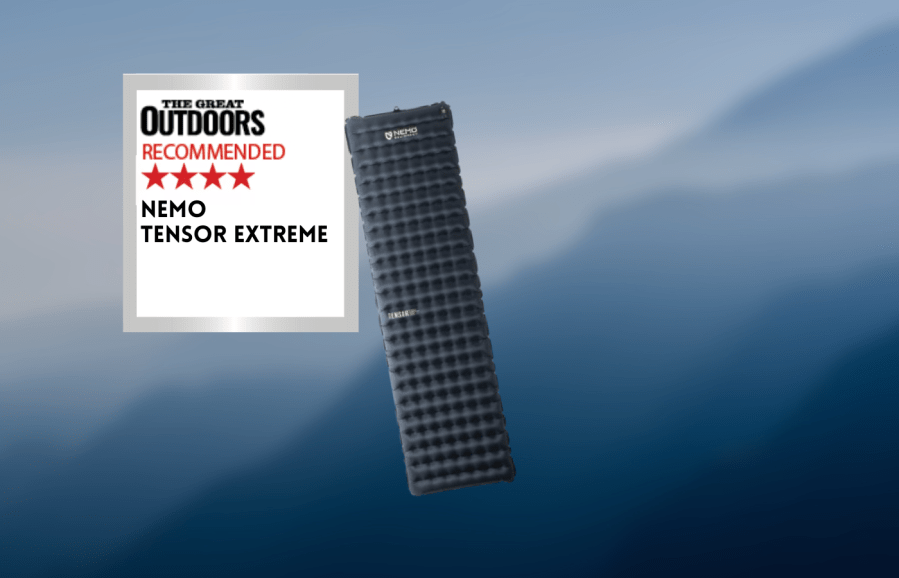
David Lintern Recommends
Overall, it’s a durable and comfortable option very cold conditions, but it may be overkill for most of the year.- Comfort
- Warmth
- Weight
- Cost
| Quick specs | |
|---|---|
| Price: £249.50 (same in dollars) Weight: 755g (Regular wide) Type: inflatable air mat Materials: 20D GRS certified Nylon, Bluesign Approved, aluminised film insulation Dimensions: 183x64cm Thickness: 9cm Rating: 8.5 Sizes: Regular, Regular mummy, long wide, regular wide Women’s version: unisex www.nemoequipment.com |
The Tensor Extreme sleeping mat, marketed as the warmest and most insulating pad on the market, is a thick air mat with a grid-based baffle structure and four layers of heat mirroring foil inside. It provides a comfortable, stable surface and is quiet when moving or turning over. Inflation is via a supplied bag, which prevents condensation buildup and improves durability. The bag is high quality, with a rubberized seal at the folding end and a nozzle that interfaces with the 2-way valve without popping off. The mat is easy to fold away and compact when packed, and weighs ¾ of a kilo. The Tensor Extreme was tested during the coldest nights of the 2023 winter season, with ground temperatures around -14C and -2C, respectively. While it is durable and comfortable in cold conditions, it may be overkill for most of the year. A repair kit is included, but a reserve mat is needed for colder conditions or in case of complete failure
Read David Lintern’s full Nemo Tensor Extreme Review
Sea to Summit Women’s Etherlight XT Insulated
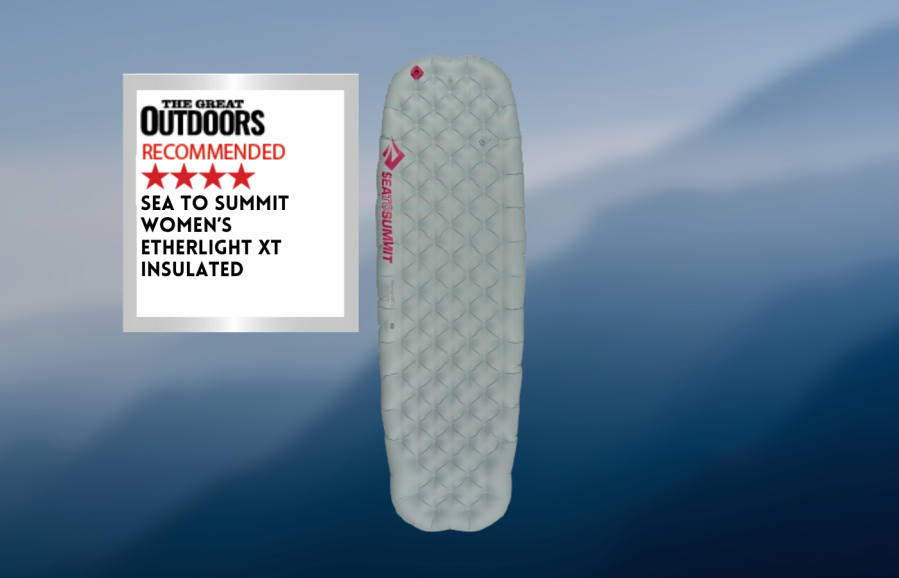
Kirsty Pallas Recommends
This mat is a very light and comfortable model, but while it has a low R-value in this test, it’s still a great option for three season camping.- Weight
- Comfort
- Low R-Value
- Pump sack shape
| Quick specs | |
|---|---|
| Price: £180 Weight: 550g Pros: Weight, comfort Cons: Lowest R-value, pump sack shape Type: Air Materials: 30D/40D nylon with TPU lamination Dimensions: 168cm x 55cm for regular Thickness: 10cm Rating: 3.5 R-value Sizes: Regular and large Men’s version: Yes, but lower R-value URL: https://seatosummit.co.uk |
Sea to Summit offers a women’s sleeping mat called the Etherlight XT Insulated, which is warmer and more comfortable than the unisex model. The mat is rectangular, narrower at the shoulders and wider at the hips and knees, making side and front sleeping more comfortable. It features air sprung cells for support and better body conformation than baffle constructions. The mat is thickest in the test, providing a close feeling to a bed.
The pump sack is built into the stuff sack and attaches to a multifunctional valve for inflating. However, the narrower stuff sack makes it difficult to inflate in a one-person tent. The mat comes with a repair kit and a pillow lock system for Sea to Summit pillows. The nylon is light and quiet, and it has an internal antimicrobial treatment to prevent mold growth.
Despite its low R-value, the Etherlight XT Insulated mat is a lightweight and comfortable option for three-season camping. It can be easily packed into a rucksack and is not rigid at 28cmx12cm. Overall, the Etherlight XT Insulated mat is a great choice for women’s sleeping mats.
Read Kirsty’s full Sea to Summit, Women’s Etherlight XT Insulated Review
Big Agnes Divide Insulated
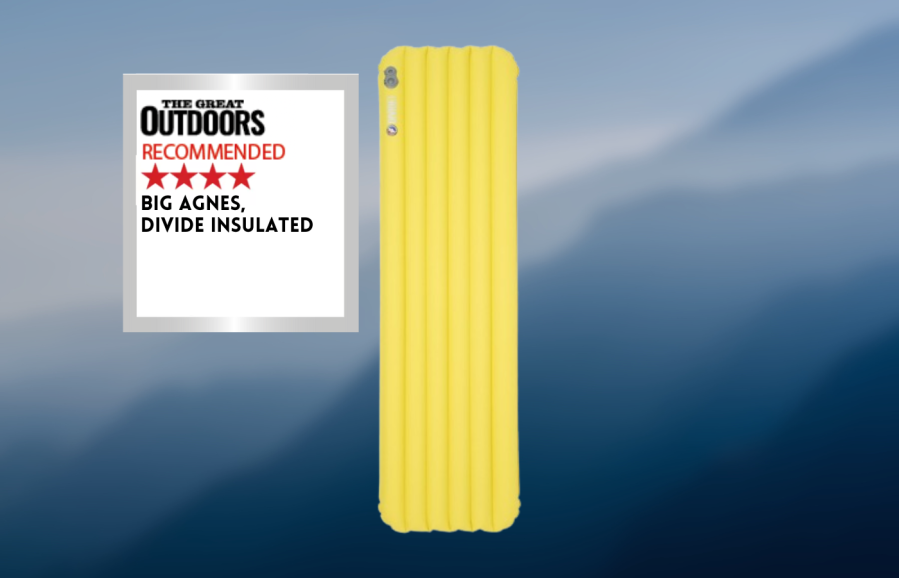
Kirsty Pallas Recommends
It’s a heavy air mat, however I think it’s a worthy compromise for the warmth when it comes in at a lower price tag than the other models.- Price
- Comfort
- Weight
- Valve position
| Quick specs | |
|---|---|
| Price: $119.95/£92 Weight: 693g Type: Air Materials: Recycled nylon ripstop, Thermolite insulation, TPU lamination Dimensions: 168cm x 51cm for petite Thickness: 9cm Rating: 4.0 R-value Sizes: Petite, regular, regular wide, wide long, and double Men’s version: Unisex URL: https://www.bigagnes.com |
Big Agnes’ Divide Insulated sleeping mat is a high-quality, affordable option for camping. It has a higher R-value, making it suitable for three-season camping and winter nights when combined with a foam mat. The insulation is provided by a built-in heat-reflecting film throughout the mat. The mat features vertical baffles that run the full length, creating a rectangular shape and providing comfort. The mat comes with a pump sack for easy pumping and a one-way valve for inflating and deflating.
A small repair kit is also included. The outer material is recycled nylon ripstop, making it durable and tough. The mat has an internal antimicrobial treatment to prevent mold buildup. The Divide Insulated packs down to 23cmx12cm but is the heaviest of the air mats, but it’s a worthy compromise for warmth at a lower price. The mat comes with a pump sack, a one-way valve, and a small repair kit.
How we tested
Chris Townsend tested the mats on high and low wild camps in the Scottish Highlands during all 4 seasons. He is around 5’8”, sleeps on his side or front and slept on snow, frozen ground, and wet ground.
Steph Wetherell tested her camping mats across hills and valleys in South Wales during winter and spring. She is plus-size and 5’10 tall so prefers a wider mat and sleeps cold so tends to opt for higher R-value mats.
Kirsty Pallas is just over five feet tall (but not quite 5’1”!), so having a short or petite mat works well. She sleeps cool when camping, so will look for a higher R-value for more insulation from the ground. These mats have been tested while camping in the Scottish Highlands through a cool and wet spring and summer. All weights are from Kirsty’s own scales, and packed sizes are measured by Kirsty.
David Lintern tested his mats over winter and spring from glen to mountain summit camps and a few inbetween, all in Highland Scotland. He sometimes used the mats together and sometimes apart and always in different shelters, to help gauge form and function. Weights are from his own scales and includes stuff sacks.
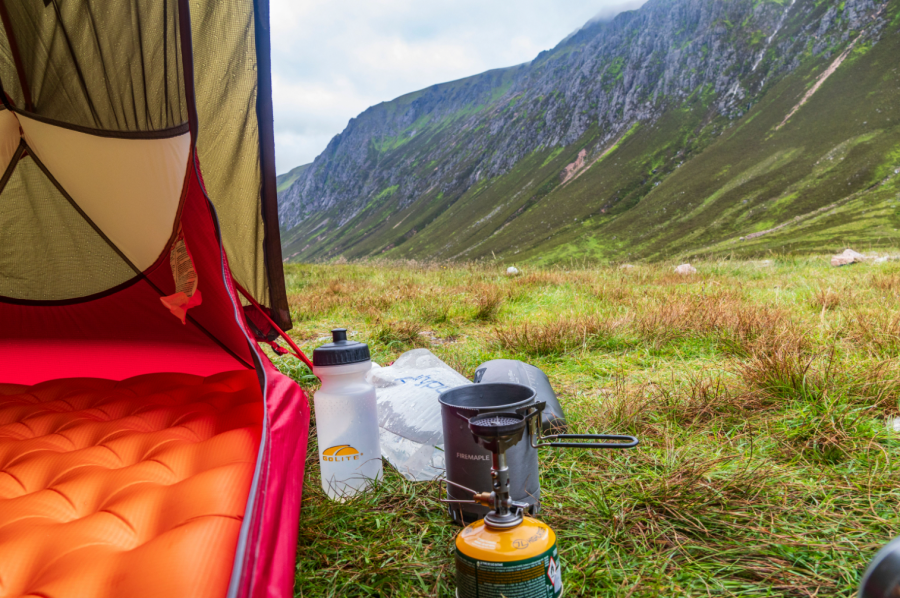
Features to look for in a sleeping mat
Type
There’s three main types of mats, which all come in at different weights, warmths, and comforts. Starting with the simplest, plain foam mats that either fold or roll up, are very light, cheap and fairly warm but bulky to carry. Next are self-inflating mats, which are foam inside an airtight outer. They pack smaller than foam mats, and give a bit more warmth and comfort, but are still a big pack size. The final type are air filled, and inflated usually with a pump sack. They’re the smallest pack size, light, and give the comfiest night’s sleep.
R-value and shape
The R-value is a standardised measure of resistance to heat loss. When applied to sleep mats the R-value indicates how well the mat will insulate us from the ground temperature. A low value around 1 might be adequate on summer camps, whilst a value of 4 or above will help to insulate against frozen ground.
Typically, sleeping pads come in two shapes. Rectangular mats offer improved comfort and allow us to move around in our sleep with less chance of touching the ground, but they take up more floor space and will weigh more. Mummy mats taper towards our feet and work well in smaller one-person tents, but feet can slip off more easily whilst asleep.
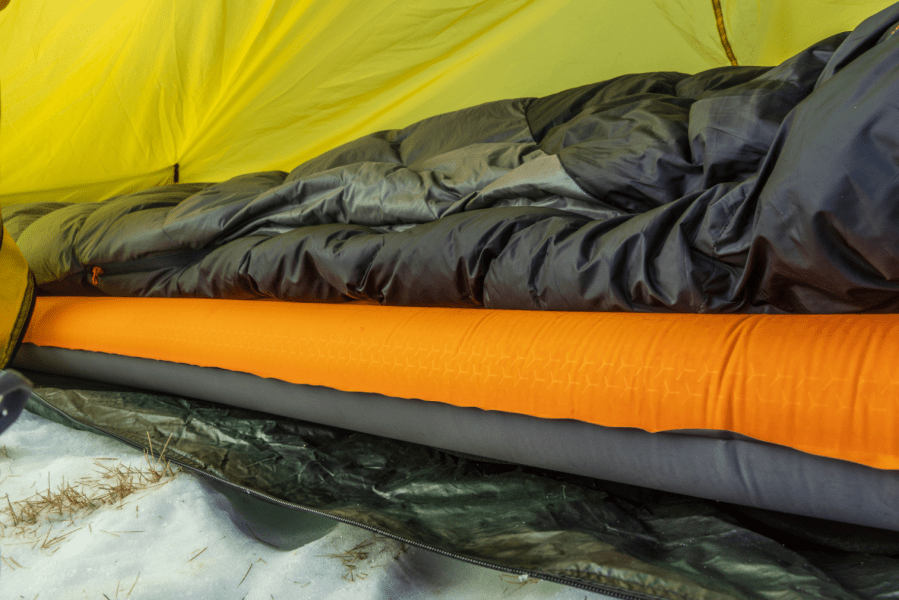
Construction
Air filled mats have baffles or cells that will affect the feeling and comfort of sleeping on them. Baffles run either horizontally or vertically along the mat, with horizontal baffles letting the mat accommodate lumpy ground, and vertical baffles give a flatter sleeping surface. Vertical baffles also often have a ‘bathtub’ feature with higher baffles on the side to stop you rolling out. The other construction type is cells, which feel more like a mattress than the classic baffles.
Weight
If we’re based at a low-level campsite and walking the hills with a return to camp for bed, a larger and heavier mat will likely be fine. If we’re carrying our overnight gear across the hills, a lighter mat will be very welcome. There is always a balance to be struck between weight and performance, depending on our plans.
Inflation
Self-inflating mats have compressed foam inside that expands when the air valve is opened. All the mats in this review must be inflated manually. All can be inflated by blowing into an air valve on the mat itself, but some models come with extra sacks that can be used as bellows to inflate the mat.
These can prolong the life of the mat by reducing moisture inside (from one’s breath), but can be fiddly and time-consuming, especially in restricted tent space. It’s worth noting that mats don’t have to be fully inflated, and that you can adjust for your own comfort level.
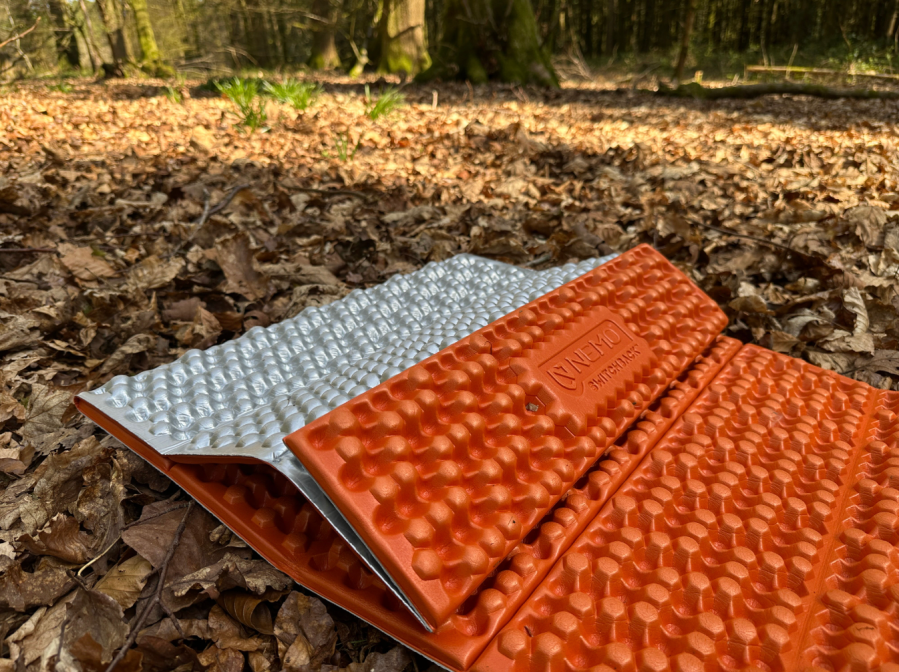
Variety
Some products can still be found in a women’s-specific format, with differing levels of insulation and different sizing. Current models come in different lengths and widths so you can pick one that best suits your body shape.
Women’s models
These are often shorter and have a higher R-value as women sleep a bit cooler, so there’s more insulation in these.
Fabric and construction
The fabric used must be supple and durable enough for multiple inflation and storage cycles. It must be puncture-resistant to prevent a night on cold or stony ground. Look for puncture repairs kits included with your mat, or take your own on camps.
Construction types vary greatly from simple sheets of foam to down-filled mats for sleeping on snow. Here we’ve concentrated on a middle range, useable in varied conditions (outside the true depths of winter). Fabric and manufacturing technology have advanced greatly, meaning that modern mats can achieve a relatively high R-value without incurring a weight penalty.
Sleeping mat construction: a guide to the different types
While all sleeping mats might be designed with the same end goal in mind – providing a comfortable night’s sleep – there’s a surprisingly amount of variation in how some sleeping mats are constructed in comparison to each other. Some are very simple and just involve a sheet of foam, others are more complex, involving closed cell foam or interlinked air chambers. Here are some of the options and their advantages and disadvantages. 25
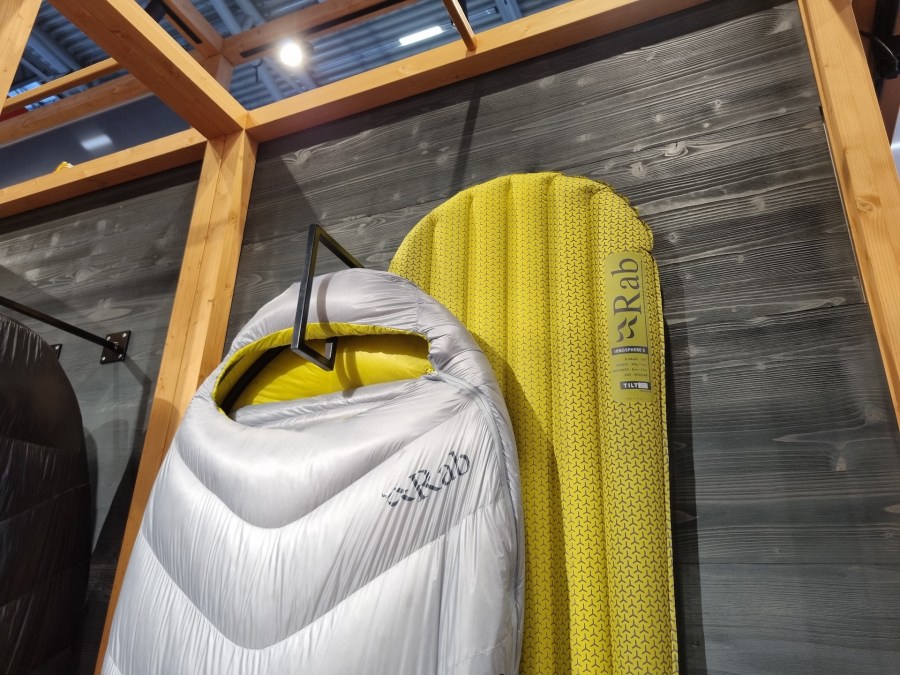
Foam Mats
Foam mats are a classic and reliable option for lightweight camping. Constructed from closed-cell foam, these mats provide a degree of comfort and insulation. The solid foam construction makes them highly durable and resistant to punctures, making them suitable for rough use and rocky terrains. They are among the lightest sleeping mat options available, making them ideal for ultralight backpackers. Foam mats offer decent insulation, making them suitable for three-season camping. Additionally, they come in various shapes, including rectangular, tapered, and mummy-shaped, catering to different preferences and body types. Foam mats are often used in winter as an extra layer of insulation underneath an inflatable mat.
Self-Inflating Mats
Self-inflating mats are a popular choice among campers due to the amount of comfort they can provide. These mats are designed with a combination of open-cell foam and an air valve that allows the mat to inflate partially on its own. The foam core provides cushioning and insulation, while the air valve allows air to enter, expanding the mat to a certain degree. To achieve the desired firmness, you may need to add a few breaths. Self-inflating mats offer good insulation, making them suitable for three-season camping and colder conditions. The combination of foam and air creates a comfortable sleeping surface that balances support and cushioning.
Inflatable Mats
Inflatable mats, also known as air mats, rely on air for cushioning and support. These mats are designed to be lightweight and packable, making them a popular choice for backpackers. They have one or multiple air chambers that you manually inflate with a pump or your breath. The materials used in inflatable mats, such as nylon or polyester with TPU coatings, provide both durability and comfort. Inflatable mats offer excellent cushioning and can be adjusted for firmness to suit individual preferences. When deflated, they can be compacted into a small size, making them easy to carry in your backpack. The level of insulation in inflatable mats varies, and some models are designed for specific temperature ranges or seasons. Additionally, inflatable mats come in different shapes, including rectangular, tapered, and mummy-shaped, offering options for various sleeping styles and space preferences. The main risk with these types of mats is that they can quickly become unusable if even just a slight puncture occurs and, due to that risk, it’s a good idea to carry a puncture repair kit with you.
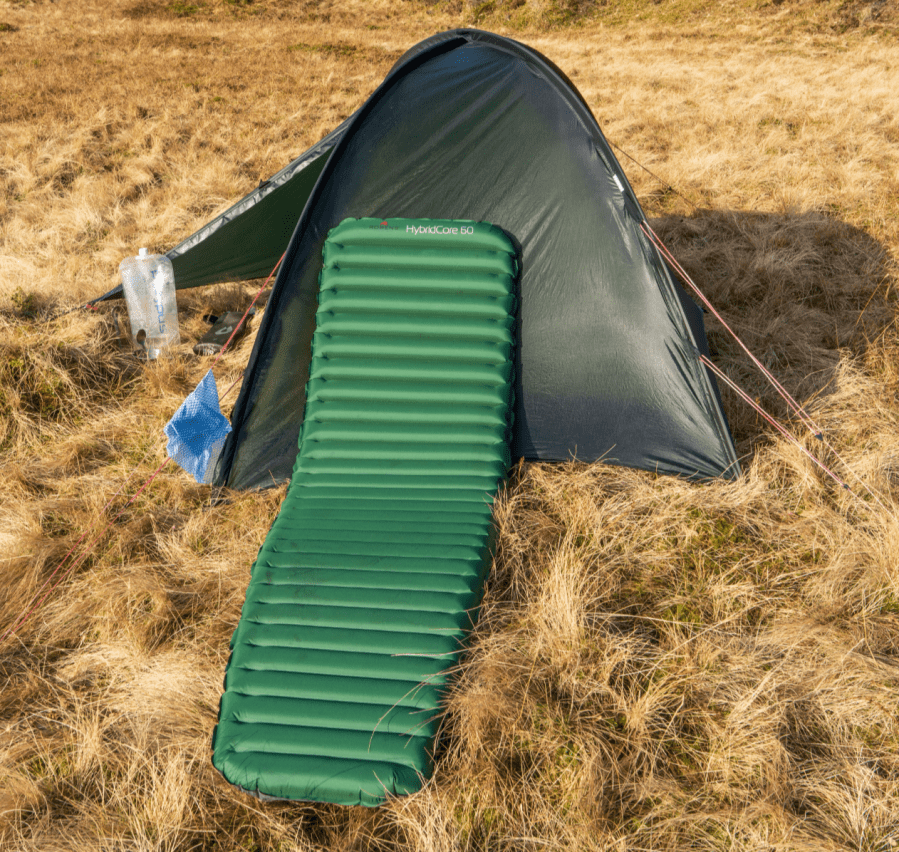
Baffle Designs
Apart from the type of sleeping mat, the baffle design also plays a significant role in comfort and performance. Baffles are the internal compartments that hold the air or foam within the mat. Different baffle designs include horizontal and vertical baffles. Horizontal tubes run across the width of the mat, providing even support but with a risk of some shifting of air or foam during the night. Vertical tubes run the length of the mat, offering more stability and preventing air or foam from shifting as much during sleep. In addition to baffle designs, you’ll find tapered mats, which are narrower at the feet and wider at the shoulders. These mats save weight and space while still providing sufficient support and comfort. On the other hand, rectangular mats offer ample space and freedom of movement, making them suitable for those who prefer sleeping in various positions.
Understanding the different types of lightweight sleeping mat constructions and baffle designs will help you select the most suitable option for your camping needs. Consider factors such as insulation, comfort, packability, and shape to ensure a restful and enjoyable night’s sleep during your outdoor adventures. Happy camping!

